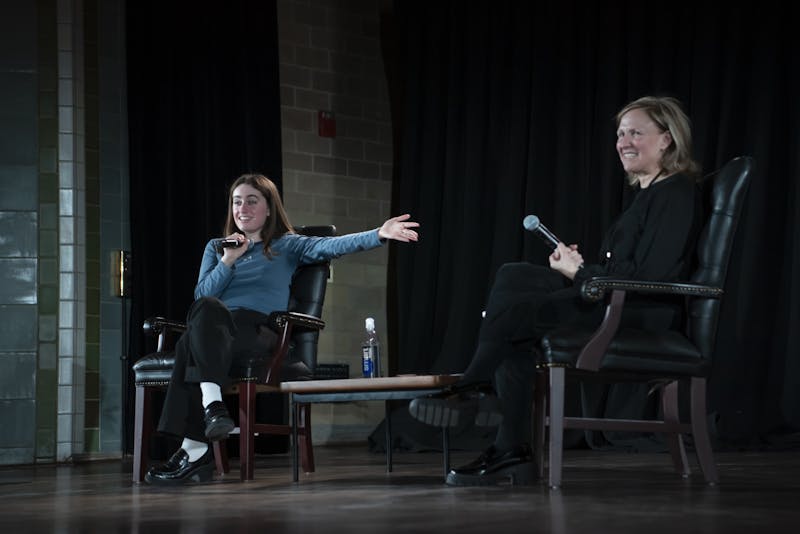Content warning: The following text describes disordered eating, student assault, and death.
It’s Nov. 19, 12 p.m., and you open your Instagram feed while you nurse the after–effects of the previous night's activities, only to be greeted by a cascade of pictures: Penn students wrapped in thermal blankets, flashing medals between their teeth, clad in their trendiest—but practical—athleisure, having conquered either a half or full marathon that morning. Or perhaps you were one of a seemingly endless quantity of Penn students who lined the Benjamin Franklin Parkway alongside the thousands of other Philadelphians (and transplants) just as the sun rose over the city.
With the phenomenon extending its reach from the student next to you in econ to your sorority sisters, it’s natural to ask the question—when did every Penn student become a marathon runner?
Annie Wu (C ‘25), who is training to race in Love Run’s half marathon this Sunday, March 24, seems to ask herself the same question about her new marathoner identity. “I hated running,” says Annie. “I very much so did not want to do more than a mile […] and then at some point, I got past three [miles], and then once you get past three … adding on the mileage was really easy. I would not have run a half [marathon] this time last year. Absolutely not.”
Annie’s change of heart can be credited to Penn’s club swim team, which she is currently co–president of. “It was kind of … a random decision between me and [co–president] Ethan. We were like, ‘oh,’ like, ‘what if we just signed up and made a team and see who would join?’” says Annie.
In the fall of 2023, many of the team’s members decided to take on the challenge of the Philadelphia Marathon individually, which the co–presidents noticed. But the real catalyst came with the July 2023 announcement that Sheerr Pool in Pottruck Health and Fitness Center, which hosts the team, would be closed for renovations during the 2024–25 school year, leaving the team without a space to practice. Seeking a way to keep the team active during a potential season on dry land, the efforts to organize group training for the Love Run began.
Annie’s choice to participate in the group effort, however, transcended the lack of practice space. “I realized that my time with swimming competitively is kind of coming to an end, probably for the rest of my life, and so I wanted to pick something up before I dropped something else,” she says.
Like Annie, finding a way to stay active is a common thread among the motivations of Penn’s marathoners. Alex Savage (C ‘26), who is also training for this month’s Love Run, says, “Once I got to college, since I wasn't participating in sports as much, I found myself not really working out as much. I could feel the difference and I wanted to get back into it. So, this has motivated me to get going.” Alex’s sentiments on the mental health benefits of training for a half–marathon are echoed by Molly Limaye (W, E ‘25). “Running has been a huge outlet for me in terms of just managing my stress and anxiety in college,” she says.
Not only do her 7:45 a.m. runs provide a reprieve from regular campus life, but they’ve rested at the center of the Penn social experience for Molly, who started running with her friend Lauren a year ago while training for the Broad Street Run. The duo invited others to tag along to their early–morning runs.
“Last semester, actually, I met a lot of friends through running, where Lauren would invite her friend and then I would become friends with them, or I'd invite my friend and Lauren would become friends [with them],” she says. “So I do feel like I've developed a running community.” Molly rarely runs alone, and as a result reflects on the impact the hobby has made on her life, saying “I feel like I've made my closest friends or built most of my strongest friendships through running.”
Striking that perfect balance in training between community and personal growth is highly individual. For Quinn Liu (E ‘25), he’s found a ratio of two–thirds training solo and one–third running with a close friend is just that balance. He isn’t the only student who finds a majority–solo training experience to be preferable.
“I'm basically training by myself. Some of my friends that did it in the fall are not doing it this spring, and I'm also someone that does better running by myself, since I can't talk while I do it. I just need to have my music in and focus,” Alex says. Despite her emphasis on the value solo–running has on her regimen, Alex still points out the importance of knowing others who have gone through the same experience. “It's helped to talk to people who've done it before.”
Even as a social runner, Molly still highlights the highly personal nature of the sport, saying “It’s just you and your brain when you’re running. There’s really not much else. No one else is influencing your experience when you run except [...] you and your goals and your brain and your thoughts.”
Running thoughts are a lot like shower thoughts for Quinn. “I actually don't run with music, so I'm always thinking really hard. So there'll be some crazy thoughts that I have so I always like to put those on my Strava runs,” he says.
“Strava” was added to my running lexicon after a few days of speaking with Penn’s marathoners, who each echoed their enjoyment of the app. The platform, which has connected over 100 million athletes, allows users to map their runs, track distance and elevation, and share their stats, photos, and thoughts from a run with friends, who can like and comment on posts.
For Alex, Strava keeps the energy flowing. “[It’s] slightly motivating to see that other people can kind of hold you accountable for doing a run. Someone can see that I did it, which helps me a little bit when I'm like ‘I don't really feel like doing this,’” says Alex. While the practice of running, particularly alone, may feel like training into the void, communicating your progress with friends and family through Strava or social media, as Molly does with her private running–themed Instagram, builds an additional layer of community support.
Outside of Strava’s running haven, the presence of training–related content on social media platforms comes with its own caveats. Creators on TikTok and Instagram tout their expensive sneakers, extensive mileage, and accelerated times unachievable for the average runner, all while appearing sweatless under the gloss of the beauty filter. These idealized training montages can perpetuate a toxic culture around the sport. “It's a sticky space because you do get the people who are super intense,” Molly says. “I think sometimes with social media, you run into the risk of perpetuating or sharing negative, or not properly backed–by–science information. And so I try to steer clear of the influencers who might be sharing things that could potentially be harmful to me or to people that run.”
Molly isn’t alone in her intentionality around the type of running content she consumes. TikTok users have highlighted a disordered eating culture around the sport frequently showcased on the app. “What I eat in a day” videos have proliferated across TikTok, many of which feature runners improperly fueling for the intensity of exercise they’re taking part in. Beyond social media, distance running has long struggled with disordered eating, with a 2021 study determining that many runners are at an increased risk of developing an eating disorder.
“I’ve found a couple running influencers who promote positivity surrounding running. They promote healthy habits surrounding proper fueling, strength training to supplement your running, lots of rest days, being flexible with your lifestyle, and giving yourself grace when you're sick, or when you're tired or injured,” says Molly. “Something that's been a huge struggle for me with running is proper fueling and nutrition. I think when you increase your training volume, you need to eat a lot more, and that's definitely been something that I've struggled with. I've actually met with a nutritionist to talk about it as well.”
Despite the individual nature of training and habit–building, marathon training doesn’t exist in a vacuum—something that becomes clear when speaking with the university’s runners. Alex and Quinn both fell into their marathon pursuits in large part because of their friends at Penn. “I saw my friends run it last semester, and I was like, ‘Holy shit, this is really cool [but] I'm not this long–distance guy,’ but I wanted to change that.” says Quinn. Penn’s addiction to sole–breaking competitions acts as a self–perpetuating habit, though, as discussed by student runners, not necessarily for worse.
External influences on training are bittersweet, a pressure that can be both motivating and stress–inducing. “It's honestly just been the social anxiety [of] not being able to do it. Like telling everyone that I'm going to run but then having to actually deliver … if you tell everyone that you're gonna do it, then ‘oh shit I got to actually, like, follow through,’” says Quinn. Outing yourself as a marathon runner can act as a motivator, but simultaneously showcases the anxiety that comes with the commitment.
One of the most daunting aspects of training for many is setting aside the time to run amidst an already–chaotic schedule stuffed with classes, seeing friends, club meetings, and self–care. In practice, it seems the challenge comes in the planning rather than the deed itself. “Honestly … a lot of the time it's like, ‘oh, I probably would have just been sitting on my couch half–doing work anyways,’” says Annie, when asked about her training regimen. “And of course, I didn't run at all last week. It was a super busy exam week for me.” She laughs, remarking that our interview happened after she went for her first run that week.
While classes make penciling in runs tough for many students, Quinn points out that, ultimately, a run is often less than an hour (“that’s less than going to Pottruck”), which is “really not that bad in terms of time,” he says. Alex expresses a similar sentiment, saying “I would always tell myself ‘oh, like I don't have time’ but you definitely have time. A workout does not have to be long. Just moving your body for like 30 minutes can make a huge difference.”
While it may only take anywhere from thirty minutes to two hours and a pair of sneakers to get out on the streets, running continues to have major economic barriers. According to the Australian Sports Commission, a correlation exists between higher income and running participation. This may be because of access to tracks, gyms, and clubs, pricey registration fees—the Love Run asks $140 per participant—or simply time to do the activity.
The college running community has recently opened conversations about the additional obstacles faced by many runners, in particular women, queer individuals, and people of color, after the death of Augusta University student Laken Hope Riley, who was attacked on a University of Georgia trail. Harassment when running poses a major obstacle. Runners report being followed by vehicles, had slurs and foul language hurled their direction, and feared for their lives while training outdoors. While students may get caught up in the stresses of their impending race, these tragedies are all–too–frequent and remind us that there are far more serious issues the running community must reckon with.
Regardless of whether they train with the friends they’ve made at Penn, participating in local marathons has fostered a sense of greater community amongst the school’s runners. “I like to run on the river trail, and there's always people running out there. Definitely a lot of people from Penn and then also just people within the Philly community, which is also really nice to see,” says Alex.
“Beyond college it's helped me become just part of the greater Philadelphia community,” says Molly. “There's thousands and thousands of people, tens of thousands of people doing it. And so it's just a big reminder [that] there's so much more to the world out there beyond just the Penn bubble that we kind of live in.”
Molly reflects on sitting in class last fall and overhearing a classmate discussing their plans to run the same half marathon as her. “I completely interrupted her conversation. I was like, 'sorry, I just like, I'm also training for the marathon like, this is so exciting,'” says Molly.
“It’s just you, and a pair of shoes and, you know, you’re running. There’s nothing else really there,” says Molly, and, for the first time, the running fever that’s swept the campus begins to seem a bit less insane.
Campus Resources:
The HELP Line: 215-898-HELP: A 24–hour–a–day phone number for members of the Penn community who seek help in navigating Penn's resources for health and wellness.
Counseling and Psychological Services: 215-898-7021 (active 24/7): The counseling center for the University of Pennsylvania.
Student Health Service: 215-746-3535: Student Health Service can provide medical evaluations and treatment to victims/survivors of sexual and relationship violence regardless of whether they make a report or seek additional resources. Both male and female providers can perform examinations, discuss testing and treatment of sexually transmissible infections, provide emergency contraception if necessary, and arrange for referrals and follow up.
Reach–A–Peer Hotline: 215-573-2727 (every day from 9 pm to 1 am), A peer hotline to provide peer support, information, and referrals to Penn students.
Penn Violence Prevention: 3535 Market Street, Mezzanine Level (Office Hours: 9 am – 5 pm Monday-Friday), 12-5pm Wednesdays & 12-5pm Fridays located in Penn Women’s Center (3643 Locust Walk).
Sexual Trauma Treatment Outreach and Prevention Team: A multidisciplinary team at CAPS dedicated to supporting students who have experienced sexual trauma.
Public Safety Special Services: Trained personnel offer crisis intervention, accompaniment to legal and medical proceedings, options counseling and advocacy, and linkages to other community resources.
Penn Women's Center: 3643 Locust Walk (Office Hours 9:30 am – 5:30 pm Monday–Thursday, 9:30 am – 5 pm Friday), pwc@pbox.upenn.edu. PWC provides confidential crisis and options counseling.





